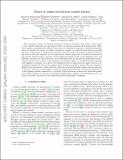| dc.contributor.author | Fraggedakis, Dimitrios | |
| dc.contributor.author | McEldrew, Michael | |
| dc.contributor.author | Smith, Raymond B | |
| dc.contributor.author | Krishnan, Yamini | |
| dc.contributor.author | Zhang, Yirui | |
| dc.contributor.author | Bai, Peng | |
| dc.contributor.author | Chueh, William C | |
| dc.contributor.author | Shao-Horn, Yang | |
| dc.contributor.author | Bazant, Martin Z | |
| dc.date.accessioned | 2021-10-27T19:52:22Z | |
| dc.date.available | 2021-10-27T19:52:22Z | |
| dc.date.issued | 2021 | |
| dc.identifier.uri | https://hdl.handle.net/1721.1/133363 | |
| dc.description.abstract | © 2020 Elsevier Ltd The microscopic theory of chemical reactions is based on transition state theory, where atoms or ions transfer classically over an energy barrier, as electrons maintain their ground state. Electron transfer is fundamentally different and occurs by tunneling in response to solvent fluctuations. Here, we develop the theory of coupled ion-electron transfer, in which ions and solvent molecules fluctuate cooperatively to facilitate non-adiabatic electron transfer. We derive a general formula of the reaction rate that depends on the overpotential, solvent properties, the electronic structure of the electron donor/acceptor, and the excess chemical potential of ions in the transition state. For Faradaic reactions, the theory predicts curved Tafel plots with a concentration-dependent reaction-limited current. For moderate overpotentials, our formula reduces to the Butler–Volmer equation and explains its relevance, not only in the well-known limit of large electron-transfer (solvent reorganization) energy, but also in the opposite limit of large ion-transfer energy. The rate formula is applied to Li-ion batteries, where reduction of the electrode host material couples with ion insertion. In the case of lithium iron phosphate, the theory accurately predicts the concentration dependence of the exchange current measured by in operando X-Ray microscopy without any adjustable parameters. These results pave the way for interfacial engineering to enhance ion intercalation rates, not only for batteries, but also for ionic separations and neuromorphic computing. | |
| dc.language.iso | en | |
| dc.publisher | Elsevier BV | |
| dc.relation.isversionof | 10.1016/j.electacta.2020.137432 | |
| dc.rights | Creative Commons Attribution-NonCommercial-NoDerivs License | |
| dc.rights.uri | http://creativecommons.org/licenses/by-nc-nd/4.0/ | |
| dc.source | arXiv | |
| dc.title | Theory of coupled ion-electron transfer kinetics | |
| dc.type | Article | |
| dc.contributor.department | Massachusetts Institute of Technology. Department of Chemical Engineering | |
| dc.contributor.department | Massachusetts Institute of Technology. Department of Mechanical Engineering | |
| dc.contributor.department | Massachusetts Institute of Technology. Department of Materials Science and Engineering | |
| dc.contributor.department | Massachusetts Institute of Technology. Department of Mathematics | |
| dc.relation.journal | Electrochimica Acta | |
| dc.eprint.version | Author's final manuscript | |
| dc.type.uri | http://purl.org/eprint/type/JournalArticle | |
| eprint.status | http://purl.org/eprint/status/PeerReviewed | |
| dc.date.updated | 2021-06-08T15:34:39Z | |
| dspace.orderedauthors | Fraggedakis, D; McEldrew, M; Smith, RB; Krishnan, Y; Zhang, Y; Bai, P; Chueh, WC; Shao-Horn, Y; Bazant, MZ | |
| dspace.date.submission | 2021-06-08T15:34:44Z | |
| mit.journal.volume | 367 | |
| mit.license | PUBLISHER_CC | |
| mit.metadata.status | Authority Work and Publication Information Needed | |
